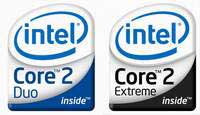 This summer, Intel’s dual-core chip (Core 2 Duo) is set to appear in computers everywhere. Joel Santo Domingo, a leading analyst from PC Magazine, presents 10 key facts about the Core 2 Duo.
This summer, Intel’s dual-core chip (Core 2 Duo) is set to appear in computers everywhere. Joel Santo Domingo, a leading analyst from PC Magazine, presents 10 key facts about the Core 2 Duo.
1. The Core 2 Duo will be the fastest processor currently available. According to preliminary test results, Intel’s dual-core chip outperforms the Pentium EE and AMD FX62 thanks to new technologies like Smart Cache and Wide Dynamic Execution.
2. The Core 2 Duo has surpassed Pentium as an essential name in today’s processors. It marks a farewell to Pentium: there will never be a Pentium 5, 6, or XX. So let’s take a moment to remember Pentium!
3. For the first time, Intel has specially created a unified core architecture for all types: Conroe for desktops, Merom for notebooks, and Woodcrest for servers/workstations. All these chips are based on Intel’s core manufacturing technology, and all three are dual-core processors.
4. All three enhanced chip types (Conroe, Merom, and Woodcrest) will provide greater power to computers while consuming less energy. This will help laptops extend battery life. Additionally, the Core 2 Duo facilitates thinner displays and workstations. The reason is that lower energy consumption means less heat output, allowing for reduced space for cooling fans in the CPU.
5. Expanding on this, lower energy consumption will cause the cooling fans to run slower, making your computer system quieter during operation. In living rooms or small office spaces, “quiet” is more important than ever.
6. Until now, the Core 2 Duo has been designed to outperform the Pentium D/EE processors (LGA775). It brings the joy of upgrade – especially for those who purchased the latest and fastest computers last summer. This excitement is also shared with manufacturers who do not want to waste money on a bunch of different components.
7. Multitasking is demonstrated at a higher level. With the true technology of the Core 2 Duo, you can turn your regular computer into multiple virtual systems, all running different applications and operating systems. For instance, theoretically, you could run an FTP server on one machine, a web server on another, and a database on a third machine while still gaming or browsing the web on a fourth. This is truly beneficial for design professionals who want to keep their virtual machines running “clean.”
8. Currently, only enterprise computers have chips that support the TPM 1.2 protection feature internally. With the Core 2 Duo, all computers will always be in a secure state. TPM (Trusted Platform Module) security technology protects passwords, access codes, boot-up, and personal data on hard drives from hackers, spyware, and identity thieves.
9. Regarding the naming conventions: Conroe, Merom, and Woodcrest are not accurate in terms of speed capability or execution performance. The reason lies in the CPU design offices located in Oregon, California, and Texas; thus, Intel’s chip names represent cities – Conroe (Texas) and Woodcrest (California). But what about Merom? It is the name of an ancient lake in Israel, suggesting that this might be where the computer chips are manufactured.
10. So when can you own one of these chips? Intel is expected to officially introduce the dual-core processors in systems within a few weeks. Rumor has it they will appear in the last week of this month. Now, all we have to do is wait for these systems in early August.




















































